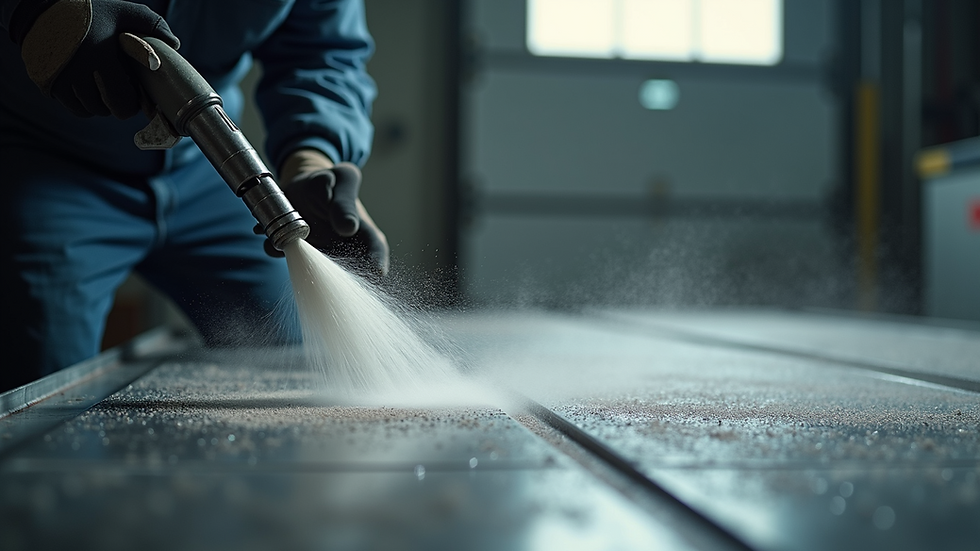Effective Metal Surface Preparation Techniques
- Mound House Powder Coating

- Nov 2
- 4 min read
When it comes to achieving a long-lasting, high-quality finish on metal surfaces, preparation is everything. Skipping or rushing this crucial step can lead to peeling, rust, and premature failure of coatings. Over my years working with metal finishing, I’ve seen firsthand how proper surface prep transforms ordinary metal into a canvas ready for excellence. Whether you’re dealing with steel beams, aluminum parts, or intricate metal components, understanding the right preparation techniques is key to success.
Exploring Essential Metal Preparation Methods
Metal preparation methods vary widely depending on the type of metal, the intended finish, and the environment it will face. Here are some of the most effective techniques I recommend for ensuring your metal surfaces are perfectly primed:
1. Mechanical Abrasion
Mechanical abrasion involves physically removing rust, scale, and old coatings using tools like wire brushes, grinders, or sandpaper. This method is straightforward and effective for small projects or touch-ups. For larger surfaces, power tools with abrasive discs or belts speed up the process.
Pros: Inexpensive, easy to control, no chemicals involved.
Cons: Labor-intensive, may not reach tight corners or complex shapes.
2. Sandblasting (Abrasive Blasting)
Sandblasting propels fine abrasive particles at high speed to clean and roughen the metal surface. This method is excellent for removing rust, mill scale, and old paint, leaving a clean, textured surface ideal for coatings to adhere.
Pros: Thorough cleaning, reaches complex shapes, creates ideal surface profile.
Cons: Requires specialized equipment and safety precautions.
For those interested in professional sandblasting services, I highly recommend checking out metal surface preparation experts who can deliver precise and consistent results.

3. Chemical Cleaning and Etching
Chemical methods use acids, alkalis, or solvents to remove contaminants like oils, grease, and rust. Etching solutions can also create a micro-rough surface to improve coating adhesion. This method is often used in industrial settings where mechanical methods are impractical.
Pros: Effective on complex geometries, removes contaminants thoroughly.
Cons: Requires handling hazardous chemicals, proper disposal needed.
4. Degreasing and Solvent Cleaning
Before any abrasive or chemical treatment, degreasing is essential. Oils and grease prevent coatings from bonding properly. Solvent cleaning uses substances like acetone or mineral spirits to wipe away these residues.
Pros: Simple, quick, and necessary step.
Cons: Solvents can be flammable and require ventilation.
What Does Surface Preparation Mean?
Surface preparation is the process of cleaning, roughening, and conditioning a metal surface to ensure coatings adhere properly and perform well over time. It’s not just about cleaning; it’s about creating the right texture and chemical environment for the finish to bond.
Think of it like preparing a canvas before painting. If the canvas is dirty or smooth, the paint won’t stick or look right. Similarly, metal surfaces need to be free of rust, oils, and old coatings, and often require a specific roughness to hold the new finish.
Proper surface preparation extends the life of coatings, prevents corrosion, and enhances the overall appearance. It’s a foundational step that should never be overlooked or underestimated.

Choosing the Right Preparation Technique for Your Project
Selecting the best metal preparation method depends on several factors:
Type of metal: Steel, aluminum, and other metals respond differently to preparation methods.
Condition of the surface: Is it rusty, painted, oily, or new?
Final coating type: Powder coating, paint, or specialized finishes like CERAKOTE require different surface profiles.
Project scale: Small parts vs. large structures.
Environmental considerations: Indoor vs. outdoor use, exposure to moisture or chemicals.
For example, if you’re preparing steel beams for powder coating, sandblasting is often the best choice to remove mill scale and create a rough surface. For aluminum parts, chemical etching combined with degreasing might be more effective.
Best Practices for Metal Surface Preparation
To get the most out of your metal preparation efforts, keep these best practices in mind:
Clean thoroughly: Remove all dirt, grease, and oils before any abrasive or chemical treatment.
Use the right abrasive: Match the grit size and type to your metal and coating requirements.
Control the environment: Work in a dry, dust-free area to prevent contamination.
Inspect the surface: Use visual and tactile inspection to ensure the surface is properly prepared.
Follow safety protocols: Wear protective gear and handle chemicals responsibly.
Test adhesion: Before full application, test the coating on a small area to confirm proper bonding.
Enhancing Durability with Expert Finishing Services
While DIY preparation can work for small projects, professional services bring expertise, equipment, and quality control that ensure superior results. Companies like Mound House Powder Coating specialize in advanced metal finishing techniques, including CERAKOTE applications, which require precise surface preparation to achieve their renowned durability and aesthetic appeal.
Partnering with experts means your metal components will not only look great but also withstand harsh conditions for years to come. This is especially important for businesses and industries where reliability and appearance are critical.
Mastering metal preparation methods is the cornerstone of any successful metal finishing project. By understanding and applying the right techniques, you set the stage for coatings that last, protect, and impress. Whether you’re tackling a small repair or a large industrial job, investing time and effort into surface preparation pays off in durability and beauty.




Comments